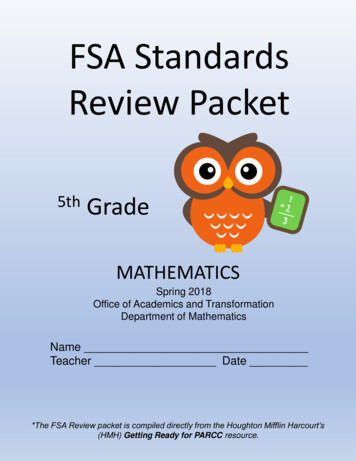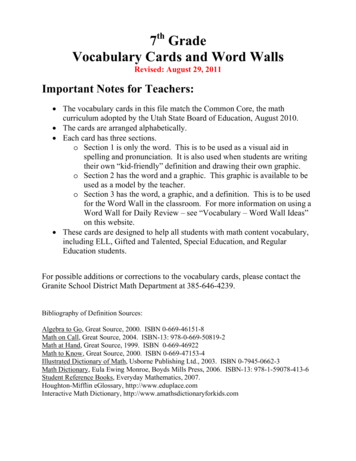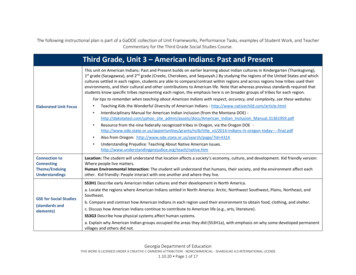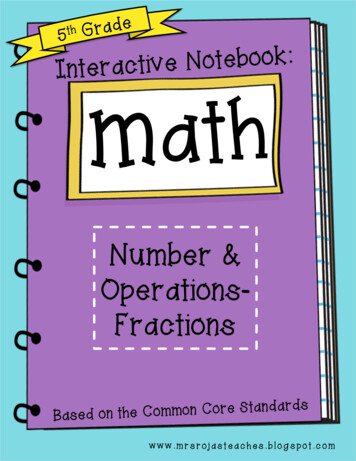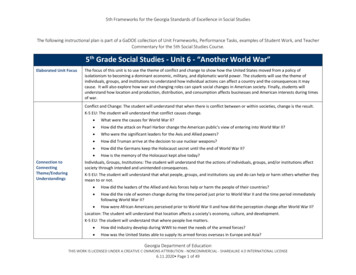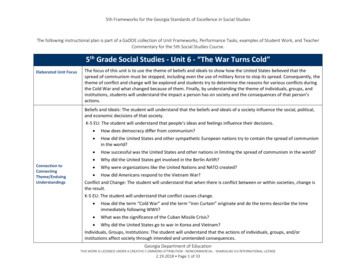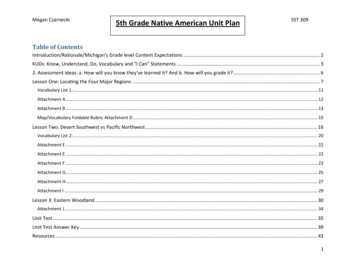
Transcription
Megan CzarneckiNative American Unit Plan5th Grade Native American Unit PlanSST 309Table of ContentsIntroduction/Rationale/Michigan's Grade level Content Expectations . 2KUDs: Know, Understand, Do, Vocabulary and “I Can” Statements . 32. Assessment ideas: a. How will you know they’ve learned it? And b. How will you grade it? . 6Lesson One: Locating the Four Major Regions . 7Vocabulary List 1: . 11Attachment A . 12Attachment B . 13Map/Vocabulary Foldable Rubric Attachment D . 15Lesson Two: Desert Southwest vs Pacific Northwest . 16Vocabulary List 2: . 20Attachment E . 22Attachment E . 22Attachment F . 23Attachment G . 25Attachment H . 27Attachment I . 29Lesson 3: Eastern Woodland. 30Attachment J . 34Unit Test . 35Unit Test Answer Key . 39Resources . 431
Megan CzarneckiNative American Unit PlanSST 3095th Grade Native American Unit PlanIntroductionIn fifth grade, the Michigan standards focus on the early history of the United States. The first era that students are introduced to isthat of the American Indians. In this unit, students will be introduced to the four general American Indian regions and how thoseregions differ from one another. Students will learn about culture, lifestyles, and the early government that was in place during thischapter of American history. By the end, students should have a stable understanding of what life was like for American Indians.RationaleAmerican history is an important topic for all Americans. These young students should have an understanding of how their countrybegan, stating with the Native Americans. Not only is it important for students to learn this information, but it needs to bemeaningful to them. They need to see how American life has changed throughout time, starting with American Indians. This unitgives students fun ways to learn and take notes on American history. With hands on activities and creative engagement, studentsshould find this topic exciting and memorable.Michigan’s Grade Level Content Expectations for this unit:5 – U1.1.1 Use maps to locate peoples in the desert Southwest, the Pacific Northwest, the nomadic nations of the Great Plains, andthe woodland peoples east of the Mississippi River (Eastern Woodland).5 – U1.1.2 Compare how American Indians in the desert Southwest and the Pacific Northwest adapted to or modified theenvironment.5-U1.1.3 Describe Eastern Woodland American Indian life with respect to governmental and family structures, trade, and views onproperty ownership and land use.2
Megan CzarneckiNative American Unit PlanSST 309KUDs: Know, Understand, Do, Vocabulary and “I Can” StatementsGLCEVerbs5 – U1.1.1 UseUse maps,maps to locatelocatepeoples in thedesert Southwest,the PacificNorthwest, thenomadic nationsof the GreatPlains, and thewoodlandpeoples east ofthe MississippiRiver (EasternWoodland).Know – What willstudents knowupon learningthis?The peoples in thedesert Southwestwere in the statesof Arizona, NewMexico, SouthernColorado and theNorthern part ofMexico. Thepeople of thePacific Northwestwere in parts ofAlaska, BritishColumbia,Washington,Oregon, Idaho,and Montana. Thenomadic nationsof the Great Plainsoccupied the areafrom theMississippi Riverto the RockyMountains andfrom Canada toMexico. And thewoodland peopleUnderstandthat – Whatwill studentsunderstand?Students willunderstandthat thedifferentnativepeopleswere locatedin fourdifferentregions inthe UnitedStates.Do – What willstudents do toshow theyunderstand?Students willcreate aenvelopefoldable mapon a blank mapof the UnitedStates that theywill draw thefour differentregions, shadeeach regionwith a differentcolor, labelingthe names ofthe regions, anddrawing andlabeling themajor landform(MississippiRiver, RockyMountains,desert, etc.)On each tabstudents willlabel the fourdifferent groupVocabularyI hwestNomadicGreat quoisI can find the fourdifferent areas thattheNative Americanslived on a map.3
Megan Czarnecki5 – U1.1.2Compare howAmerican Indiansin the desertSouthwest andthe PacificNorthwestadapted to ormodified theenvironment.Native American Unit PlanCompareeast of theMississippi River(EasternWoodland)occupied the areafrom the Atlanticto the MississippiRiver, includingthe Great LakesNative Americansadapted to andmodified theenvironmentwhere they lived.American Indiansin the desertSouthwest weremostly farmers,hunters, andgatherers. Theylived near waterwhere the riverswould flood towater corn cropsand made homesout of adobe (clay,straw, dung) andwore littleclothing. ThePacific NorthwestIndians used theSST 309regions, Undereach tabstudents will listthe states inthat region.Students willunderstandthat theSouthwestIndians liveddifferentlythan thePacificNorthwestIndians.In groups,students willmake models ofthe differentlifestyles of theSouthwest andPacificNorthwestIndians.Students willmakerepresentationsof the differentshelters,differentclothing, anddifferent waysof obtainingfood. Studentswill thenpresent theirmodels to theAdobeBig HouseAdaptModifyHunters andGatherersI can describe thedifferences betweenthe NorthwestIndians' lifestyle andthe SouthwestIndians' lifestyle.4
Megan Czarnecki5-U1.1.3Describe EasternWoodlandAmerican Indianlife with respectto governmentaland familystructures, trade,and views onpropertyownership andland use.Native American Unit PlanDescribetrees in the foreststo build BigHouses. Theyhunted seals, fish,and whales. Usedcedar bark tomake clothing forcold seasons.The EasternWoodlandAmerican Indianshad a democraticgovernment. 5tribes created acouncil to agreeupon bigdecisions. Therivers allowedthese people totrade. The largecities were slavecities where slaveswere to marryhigh rankingwomen. Womenwere shown agreat deal ofrespect.SST 309class. Studentswill write upcomparisonsbetween themodels.Students willunderstandthe lifestyleand customsof theEasternWoodlandIndians.Students willcreate analphabet book,each page has aletter of thealphabet witheach letterrepresenting anaspect of theEasternWoodlandIndian lifestyle.Students willhave to draw apicture anddescribe eachof the pages.The words theyuse for eachletter can bewords that theylearned frompreviousIroquoisCherokeeHunters andGatherersFur TradeSettlersChiefEuropeanSettlersI can describe the lifeof Eastern WoodlandIndians.5
Megan CzarneckiNative American Unit PlanSST 309lessons in thisunit.2. Assessment ideas: a. How will you know they’ve learned it? And b. How will you grade it?a) Students will create a foldable that has a map in the middle that students have labeled the four different Native Americanterritories. Also, on each tab, students will put 4 vocabulary words and definitions and a picture that represents each NativeAmerican group. The foldable will be graded on a rubric.b) Students will create a journal entry after each lesson discussing something they learned and a question they still have. Studentswill be graded on completion of both.c) After reading Plank House and Pueblo, students will work in groups to create a Venn Diagram to compare the similarities anddifferences between the environments of the Pacific Northwest and Southwest and how the Native Americans living in thoseareas adapted to their environments.d) Students will create a foldable booklet with each page containing a vocabulary word, a picture, the definition in their ownwords, and a sentence using that vocabulary word. They will continue to add to this booklet as they progress through the unit.Each part will be worth a point.***e) Students will work in groups to create a model representation of the shelter, the clothing, and different ways of obtaining foodfor either the Pacific Northwest or Southwest Native Americans. Students will be graded with a rubric (or a checklist?).f) Students will write a persuasive paragraph explaining which of the four areas they would rather live in and why.g) Students will create an alphabet book with each page containing each letter of the alphabet and they must choose an aspect ofthe Eastern woodland lifestyle that starts with the letter of the alphabet. They must also include a picture and a sentenceexplaining the aspects they chose. This will encompass all four regions of Native Americans. Students will be graded with achecklist.h) Unit Test6
Megan CzarneckiNative American Unit PlanSST 309Lesson One: Locating the Four Major RegionsTIME 1 dayGLCEVerbs5 – U1.1.1 UseUse maps,maps to locatelocatepeoples in thedesert Southwest,the PacificNorthwest, thenomadic nationsof the Great Plains,and the woodlandpeoples east of theMississippi River(EasternWoodland).Know – What willstudents knowupon learningthis?The peoples in thedesert Southwestwere in the statesof Arizona, NewMexico, SouthernColorado and theNorthern part ofMexico. Thepeople of thePacific Northwestwere in parts ofAlaska, BritishColumbia,Washington,Oregon, Idaho,and Montana. Thenomadic nationsof the Great Plainsoccupied the areafrom theMississippi Riverto the RockyMountains andfrom Canada toUnderstandthat – Whatwill studentsunderstand?Students willunderstandthat thedifferentnative peopleswere located infour differentregions in theUnited States.Do – What willstudents do toshow theyunderstand?Students willcreate aenvelopefoldable map ona blank map ofthe UnitedStates that theywill draw thefour differentregions, shadeeach region witha different color,labeling thenames of theregions, anddrawing andlabeling themajor landform(MississippiRiver, RockyMountains,desert, etc.)On each tabstudents willVocabularyI hwestNomadicGreat quoisI can find the fourdifferent areas thattheNative Americanslived on a map.7
Megan CzarneckiNative American Unit PlanMexico. And thewoodland peopleeast of theMississippi River(EasternWoodland)occupied the areafrom the Atlanticto the MississippiRiver, includingthe Great LakesSST 309label the fourdifferent groupregions, Undereach tabstudents will listthe states in thatregion.2. Assessment ideas: a. How will you know they’ve learned it? And b. How will you grade it?a) Students will create a foldable that has a map in the middle that students have labeled the four different Native Americanterritories. Also, on each tab, students will put 4 vocabulary words and definitions and a picture that represents each NativeAmerican group. The foldable will be graded on a rubric.b) Students will create a journal entry after each lesson discussing something they learned and a question they still have. Studentswill be graded on completion of both.Lessons: How will you take themwhere they need to go? (Step-byStep plan from A-Z)Instructional strategies/Social constructs:How will they work?(AND what will YOU do?)Anticipatory Set:Students will be shown a shortpowerpoint with different maps of theUnited States and discuss as a class thecharacteristics of the country thatpeople would be challenged with.Students will first be shown the map withthe state boundaries.What would this map look like without thestates?Then show them the physical map thatshows the names of major places andlandforms, then show them the blankResources needed: What materials andresources will they need?(Page #s read, graphic organizers, books,posters, realia, etc ) Anticipatory Map Power Point8
Megan CzarneckiThe teacher will tell students what theywill be able to do after this lesson ( "ICan" statement):You will be able to find the four differentareas that the Native Americans lived ona map.Students will be given a blank map thatthey will begin to label the majorlandforms, river, and bodies of water ofthe United States (i.e. the Pacific Ocean,the Rocky Mountains, the desert, theplains, the Mississippi River, the AtlanticOcean, etc.)This map will later be used to label thefour different Native American regions.Native American Unit Planphysical map.How might we divide the country now? Byland forms? By climate?Explain to them the main characteristics ofthe four different Native American regions(i.e. the land west of the mountains buteast of the Mississippi river is the vastgrassy plains, etc.) Show them thepictures of the four different regions. Foreach, ask them:What about this landscape would make iteasy to survive? What would make ithard?Is it impossible to survive in any of theseareas? Which area do you think would bethe hardest to live in and why?Students will use atlases to locate anddraw the major landforms, rivers, andbodies of water on their blank map.When they have finished, the class will beshown a completed map that they will useto check if they have all the right labels inthe correct placeSST 309 Blank map (Attachment A)Colored PencilsAtlasCompleted Map (Attachment B)9
Megan CzarneckiVocabulary lesson:Using the Kids Discover magazine America1492 students will be introduced to thevocabulary: American Indian, territory,region, desert, Pacific Northwest,nomadic, Great Plains, Eastern WoodlandIndians, Apache, Chinook, Sioux,Cheyenne, and Iroquois. (GLCE 5 – U1.1.1)Native American Unit PlanSST 309The magazine can be displayed on an Elmoand only the useful pages shown.Students can follow along with their ownmagazines (if provided). Kids Discover: America 1492 Portable Word Wall (AttachmentC)Students can use an envelope foldable (pg27 big Book of Social Studies).After they have labeled their blank mapswith the four American Indian regions, thiswill be added to the foldable on the inside.Students will label and highlight each area(Great plains, Eastern Woodland, etc.) andon each tab of the foldable the will writethe names of the areas and Indian groupswith a description of the vocabulary wordsalong with a picture (picture on top of tab,description on the back) Paper and markers for envelopefoldable Rubric (Attachment D) Kaya and the River Girl by JanetShaw Notebook paperThe words will be added to the word wall.Extension (if there is time)Journal EntryTeacher will read Kaya and the River Girlby Janet Shaw during down time betweenlessonsStudents will write a short paragraph ofwhat they have learned and a questionthey still have10
Megan CzarneckiNative American Unit PlanSST 309Vocabulary List 1: Native American/American Indian- the first Americans to be born in North AmericaTerritory- a large area of land assigned or controlled by a nation of peopleRegion- a large land area that has geographic, political, or cultural characteristics that distinguish it from othersDesert- an area of land, usually in very hot climates, that consists only of sand, gravel, or rock with little or no vegetations, nopermanent bodies of water, and irregular rainfallo not dessert!Pacific Northwest- a part of the northwestern United States on the Pacific coast that includes the states of Washington andOregon and sometimes southwestern British Columbia, CanadaNomadic- a member of a people who move seasonally from place to place to search for food and water or pasture for theirlivestockGreat Plains- a relatively dry region East of the Rocky Mountains in the US and CanadaEastern Woodland Indians- the Native Americans living in the forests East of the Mississippi River to the Atlantic coastApache- a member of a group of North American Indians of the Southwest United StatesChinook- a member of a group of North American Indians of Washington and OregonSioux- a member of a group of North American Indians of Northern United States and Southern CanadaCheyenne- a member of a group of North American Indians of the Western Great PlainsIroquois- a member of a group of North American Indians of the Eastern United States3-4 of the vocabulary words and their definitions should be under each tab of the envelope foldable. The name of the AmericanIndian region will be on the top of each tab with a corresponding picture.11
Megan CzarneckiNative American Unit PlanSST 309Attachment A12
Megan CzarneckiNative American Unit PlanAttachment BSST 309***Portable Word Wall is a separate attachment because the paper is not landscape***13
Megan CzarneckiNative American Unit PlanSST 30914
Megan CzarneckiNative American Unit PlanSST 309Map/Vocabulary Foldable Rubric Attachment D3 PointsMap is neat with colorsand correctrepresentation of thePacific Ocean, theAtlantic Ocean, theRocky Mountains, thedessert, the Great Plains,and the MississippiRiver2 pointsMap is neat with colorswith most of the majorwater and landformscorrectly labeled1 pointMap is not neat withlittle color and the waterand land form are not allcorrectly labeled2 of the 4 regions arecorrectly labeledTop tabs are labeledwith the four regions butdo not have acorresponding picture0 pointsMap is not complete, nocolor, water and landforms are not all presentor correctly labeled1-0 of the 4 regions arecorrectly labeledThe top tabs have nolabel nor a pictureCorrectly labeled all 4 ofthe regions: theSouthwest region, thePacific Northwestregion, the Great Plainsregion, and the EasternWoodland regionTop tabs are labeledwith the four regionswith a neat and colorfulpicture that relates to thelabel3-4 vocabulary wordscorrectly spelled withthe correct definition ofeach on all four tabs3 of the 4 regions arecorrectly labeledTop tabs are labeledwith the four regions butthe pictures are not neator do not relate to thelabel3-4 vocabulary words oneach tab, but the wordsare misspelled and thedefinitions are notcorrect1-2 vocabulary words oneach tab with thecorresponding definition1-2 Vocabulary wordsare misspelled withincorrect definitions15
Megan CzarneckiNative American Unit PlanSST 309Lesson Two: Desert Southwest vs Pacific NorthwestTIME 2-3 daysGLCE5 – U1.1.2Compare howAmerican Indiansin the desertSouthwest and thePacific Northwestadapted to ormodified theenvironment.VerbsCompareKnow – What willstudents knowupon learningthis?Native Americansadapted to andmodified theenvironmentwhere they lived.American Indiansin the desertSouthwest weremostly farmers,hunters, andgatherers. Theylived near waterwhere the riverswould flood towater corn cropsand made homesout of adobe (clay,straw, dung) andwore littleclothing. ThePacific NorthwestIndians used thetrees in the foreststo build BigHouses. TheyUnderstand that –What willstudentsunderstand?Students willunderstand thatthe SouthwestIndians liveddifferently thanthe PacificNorthwestIndians.Do – What willstudents do toshow theyunderstand?In groups, studentswill make modelsof the differentlifestyles of theSouthwest andPacific NorthwestIndians. Studentswill makerepresentations ofthe differentshelters, differentclothing, anddifferent ways ofobtaining food.Students will thenpresent theirmodels to the class.Students will writeup comparisonsbetween themodels.Vocabulary I CanAdobeBig HouseAdaptModifyHuntersandGatherersI can describe thedifferencesbetween theNorthwest Indians'lifestyle and theSouthwest Indians'lifestyle.16
Megan CzarneckiNative American Unit PlanSST 309hunted seals, fish,and whales. Usedcedar bark tomake clothing forcold seasons.2. Assessment ideas: a. How will you know they’ve learned it? And b. How will you grade it?a) After reading Plank House and Pueblo, students will work in groups to create a Venn Diagram to compare the similarities anddifferences between the environments of the Pacific Northwest and Southwest and how the Native Americans living in thoseareas adapted to their environments.b) Students will create a booklet with each page containing a vocabulary word, a picture, the definition in their own words, and asentence using that vocabulary word. They will continue to add to this booklet as they progress through the unit. Each partwill be worth a point.c) Students will work in groups to create a model representation of the shelter, the clothing, and different ways of obtaining foodfor either the Pacific Northwest or Southwest Native Americans. Students will be graded with a rubric (or a checklist?).Lessons: How will you take themwhere they need to go? (Step-byStep plan from A-Z)Vocabulary lesson:Using the Kids Discover magazine NativeAmerica students will be introduced to thevocabulary: Hunters, gatherers, farmers,Anasazi, drought, Navaho, mesa, plankhouse, affluent, pueblo, potlatch, nomads,teepee, Mound Builders, Stinkards,Cahokian City, wigwams, long house,Sachems modify, trade, settlers,Instructional strategies/Social constructs:How will they work?(AND what will YOU do?)Students can use a word map for eachvocabulary word. They will write theword, write what they think it means,write the definition in their own words,draw a picture, and use the word in asentence. Students can work on this whilethe magazine is being presented or insmall groups. Students will use themagazine to look back on to create theirown definitions and descriptions. Theword maps will be attached together toResources needed: What materials andresources will they need?(Page #s read, graphic organizers, books,posters, realia, etc ) Kids Discover: Native America Word Map (Personal VocabularyJournal) Attachment E Portable Word Wall (Attachment17
Megan CzarneckiNative American Unit PlanSST 309create a booklet.The words will be added to the word wall.Teacher will tell students what they will beable to do after this less ("I Can"statement):You will be able to describe the differencesbetween the Northwest Indians' lifestyleand the Southwest Indians' lifestyle.The teacher will go over the Power Point“A Glance at the First Americans” slides 121The teacher will read to the class PlankHouse by Dolores DyerThe teacher will read to the class Puebloby R. Kent RasmussenThe teacher will also show student theartwork of the Pacific Northwest andSouthwest IndiansThe teacher will guide the studentsthrough a Venn diagram comparing whatthey have learned from the two books.Teacher will present students withprimary sources from the Library ofCongress to compare the differencesbetween the Pacific Northwest andSouthwest Indians.Students will follow along with the powerpoint by taking notes on the guided notesheet provided.Students will be divided into two groups.On the white board will be two Venndiagrams, one for each group. The groupsmust work together to compare thedifferences and similarities of the PacificNorthwest and Southwest lifestyle fromthe information they learned from thebook.From the home page of the LOC,www.loc.gov, click on the square calledPrints and Photographs. In the searchbox, type Southwest American Indians.See # 3 “Native Americans of theSouthwest” and explore the picturesprovided. Write four or five notes on the Power Point “A Glance at the FirstAmericans”Note Sheet (Attachment G)Note Sheet Key (Attachment H)Plank House by Dolores DyerPueblo by R. Kent RasmussenWhite boardDry Erase MarkersPictures of artwork (Attachment F) Computers with internet access18
Megan CzarneckiNative American Unit PlanSST 309kinds of clothing, shelters, environment,and lifestyle you observe from thesepictures. Go back to Prints andPhotographs and search NorthwestAmerican Indians. See # 5 “PacificNorthwest and Alaska Indian Portraits andscenes” and write four or five notes on thekinds of clothing, shelter, environment,and lifestyle you observe from thesepictures. Make a Venn Diagramcomparing the similarities and differencesof the lifestyles you saw in the pictures ofthe Southwest and Northwest AmericanIndians.Extension (if there is time)From read.gov, provide students with thebooks Philip, Neil. ed. A Braid of Lives:Native American Childhood. Clarion Books,2000. And Alexie, Sherman. “TheAbsolutely True Diary of a NativeAmerican Indian.” Little, Brown Books forYoung Readers, 2007. Read as a class andhave students make their own shortstories about the life of American Indians. computer with internet accessTeacher tells students that they will beable to show the difference betweenthese two Native American groups bycreating models of their life styles. Theteacher will divide students into groups.Each group will make a model ofStudents will make a model of one of thefollowing: the home of the SouthwestIndians, the home of the NorthwestIndians, the clothing of the SouthwestIndians, the clothing of the NorthwestIndians, the ways of obtaining food of the Construction PaperScissorsMarkersGlueChecklist (Attachment I)19
Megan Czarneckisomething that represents the way of lifefor either the Pacific Northwest orSouthwest Indians.Journal EntryNative American Unit PlanSouthwest Indians, the ways of obtainingfood of the Northwest Indians, or someother authentic item that was used by oneof the two groups (a game played by theNative Americans or a tool or totem pole).Students will be provided some materials,but any extra materials they will have toprovide themselves. They must create ashort presentation about their model thatthey will share with the class. After,students will write a short papercomparing the differences between thelifestyles (This project should be workedon each day for 20-30 minutes during theweek)Students will write a short paragraph ofwhat they have learned and a questionthey still haveSST 309 Notebook paperVocabulary List 2: Hunters: they made spearheads out of lint and missile launchers to hunt animalsGatherers: they collected roots and berriesFarmers: they bred plants, corn, potatoes, and squashAnasazi: These American Indians made their homes on the stone shelf of mountains.Drought: a long period of extremely dry weatherNavaho: These American Indians made their house called pueblos out of sun-dried clay called adobe.Mesa: flat topped mountainPlank House: long houses made of wooden planksAffluent: wealthyPotlatch: a big feast that lasted for days and when it was over the host would give away most of his finest possessions to hisguests20
Megan Czarnecki Native American Unit PlanSST 309Nomads: people who move from place to placeTeepee: tent-like home made from animal skinsMound Builders: Native Americans who created hills of dirt for graves, temples, and religious symbolsStinkards: slaves captured from battles between tribesCahokian City: great trading cityWigwams: houses made of branches lashed together and covered in barkLong House: houses made of wood, very longSachems: Eastern Woodland chiefsTrade: the exchange of goodsSettlers: new people who come to a place to liveModify: to change21
Megan CzarneckiNative American Unit PlanS
5th Grade Native American Unit Plan Introduction In fifth grade, the Michigan standards focus on the early history of the United States. The first era that students are introduced to is that of the American Indians. In this unit, students will be introduced to the four general American Indi
